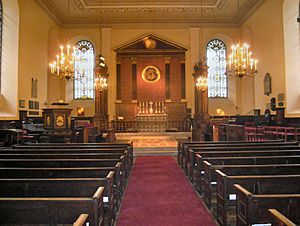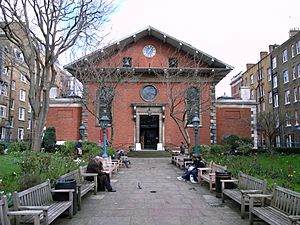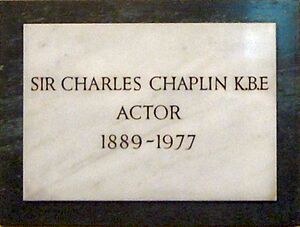St Paul's, Covent Garden facts for kids
Quick facts for kids St. Paul's, Covent Garden |
|
|---|---|

St Paul's at Covent Garden in June 2023
|
|
| 51°30′41″N 0°7′27″W / 51.51139°N 0.12417°W | |
| Location | Bedford Street, Covent Garden, London |
| Country | England |
| Denomination | Church of England |
| Churchmanship | High Church |
| Website | http://www.actorschurch.org/ |
| Architecture | |
| Heritage designation | Grade I |
| Architect(s) | Inigo Jones |
| Years built | 1631–1633 |
| Administration | |
| Diocese | London |
St Paul's Church is a special church in Covent Garden, central London. It was designed by a famous architect named Inigo Jones way back in 1631. He was asked to build it for the Earl of Bedford, who wanted new homes and buildings for important people.
This church is often called "the actors' church." This is because it has a long history with the theatre world, especially the famous West End shows nearby. It was the first completely new church built in London after the Reformation.
There's a fun story about its design. The Earl of Bedford supposedly asked Inigo Jones to design a simple church, "not much better than a barn." Jones replied, "Then you shall have the handsomest barn in England!"
Contents
A Look at the Church's Design
Inigo Jones designed St Paul's to look like an ancient Roman temple. It has a big front entrance with columns, called a portico, facing the main square. However, this was never the real main entrance! The altar is actually behind this wall. The main way to get into the church is at the other end.
The front of the church is made of stone now, but it was originally brick with a smooth finish called stucco. The other sides of the building are still brick with stone details. The triangular parts at the top, called pediments, are made of wood.
Church History
In 1630, the Earl of Bedford got permission to rebuild an area he owned in London. This led to the creation of the Covent Garden Piazza, which was London's first formal square. The new buildings around it had a classic style, and the church was built at the west end.
The church was finished in 1633. It cost the Bedford family about £4,886, which was a lot of money back then! It wasn't officially opened until 1638 because of a disagreement. For a while, it was just a small chapel. But in 1646, Covent Garden became its own separate area, and the church was dedicated to St. Paul.
In 1789, the church had a big makeover led by architect Thomas Hardwick. Just six years later, in 1795, a fire accidentally started by workers on the roof burned out the inside of the church. Luckily, the outside walls were still strong, and the church was rebuilt again by Hardwick. It reopened in 1798. Even though the church was badly damaged, its important records and the beautiful pulpit (where sermons are given) were saved. The pulpit was made by a famous wood-carver named Grinling Gibbons.
Architectural Details
The front of the church, facing the piazza, has a large stone portico with a big triangular pediment supported by columns. There used to be three doorways behind this portico. The middle one was actually a fake door because the altar is right behind it. The other two were blocked up later. The main entrance to the church is through the plainer west side.
The outside walls were originally covered in stucco, not bare brick. In 1789, they decided to cover the walls with Portland stone as part of a big renovation. The roof was also changed from tiles to slate. However, when this stone covering was removed in 1888, it was found to be very thin and not well attached to the brick. So, the church was then covered in the red brick you see today.
Over the years, the ground level of the Piazza slowly rose. This meant the steps leading up to the portico disappeared. By 1887, there were no steps left. The arches next to the portico were made wider and taller during a restoration between 1878 and 1882.
Inside, the church is one large open space. It doesn't have columns dividing it. Galleries (balconies) were added soon after it was built, and the one on the western side is still there today.
Theatrical Connections
St Paul's Church has been linked to the theatre world since 1663, when the Theatre Royal, Drury Lane opened nearby. This connection grew even stronger in 1723 with the opening of the Covent Garden Theatre, which is now the Royal Opera House.
In 1662, Samuel Pepys wrote in his diary about seeing the first "Italian puppet play" under the church's portico. This was the first recorded performance of "Punch and Judy" in England! Every May, there's an annual MayFayre service to celebrate this.
The portico of St Paul's was also the setting for the first scene of Shaw's famous play Pygmalion. This play was later made into the musical My Fair Lady. Since 2007, St Paul's has had its own professional theatre company called Iris Theatre.
Famous People and Memorials
Many famous people have connections to St Paul's Church. The artist J. M. W. Turner and the writer Sir William S. Gilbert (who wrote the famous Gilbert and Sullivan operas) were both baptised here.
Some notable people buried at St Paul's, Covent Garden, include the wood-carver Grinling Gibbons, painters Thomas Murray, Sir Peter Lely, and Thomas Girtin. Also, Thomas Arne, who composed "Rule Britannia," and Sir Henry Herbert, who was a censor for the theatre, are buried here.
There are many memorials inside the church dedicated to famous entertainment personalities from the 20th century. These include Sir Charlie Chaplin, Sir Noël Coward, Dame Gracie Fields, Stanley Holloway, Boris Karloff, Vivien Leigh, Ivor Novello, Richard Greene, Diana Rigg, and Richard Beckinsale. There's also a plaque for the music hall star Bransby Williams.
The church is surrounded by a beautiful garden that used to be a graveyard. Burials stopped there in 1852.
Notable Events
In the 1980s, the area right outside the church was a popular spot for bands to perform. On April 1, 1984, the first samba school in Britain, the London School of Samba (LSS), had its very first public concert here. They had another concert a week later. The LSS was formed in January 1984 and is seen as the "godmother" of samba in the United Kingdom. Later that year, the LSS was also the first samba school to parade in the Notting Hill Carnival.
Covent Garden Sinfonia
Covent Garden Sinfonia is a professional chamber orchestra that performs regularly at the Actors' Church. They used to be called the Orchestra of St Paul's until June 2017. Besides their concerts in Covent Garden, they perform all over the UK. The orchestra changes in size for each project, from a small group to a full symphony orchestra with 70 or more musicians.
Images for kids
-
Statue of the Conversion of St Paul was sculpted by Bruce Denny and was unveiled by Dame Judi Dench
-
The pulpit was the work of Grinling Gibbons
-
The ashes of Dame Ellen Terry
-
Memorial Plaque to composer Thomas Arne
-
Memorial Plaque to Charlie Chaplin
-
Covent Garden Piazza painted in 1737 by Balthazar Nebot
See also
- List of churches and cathedrals of London
- Crown Court Church – located nearby
- Saint Malachy's Roman Catholic Church, New York City, also known as the Actors' Church
















